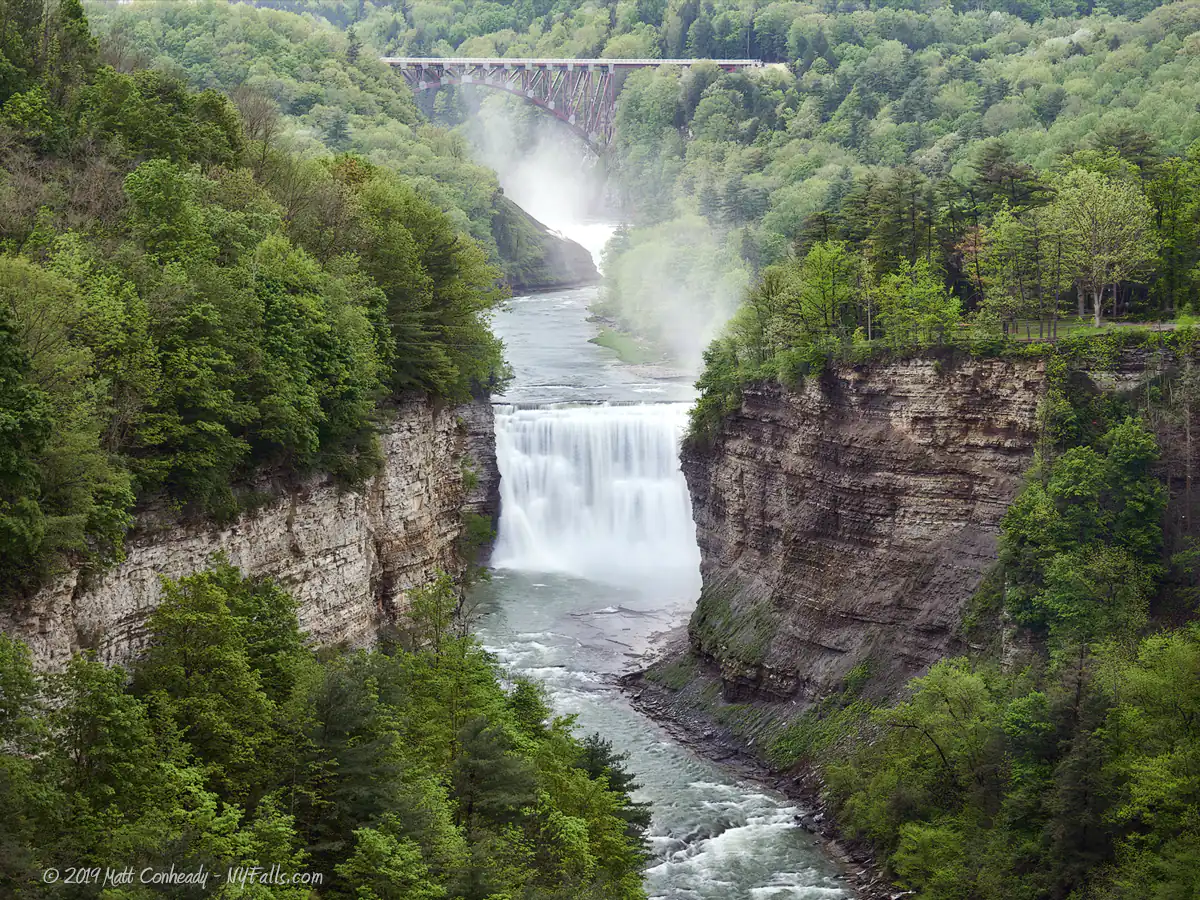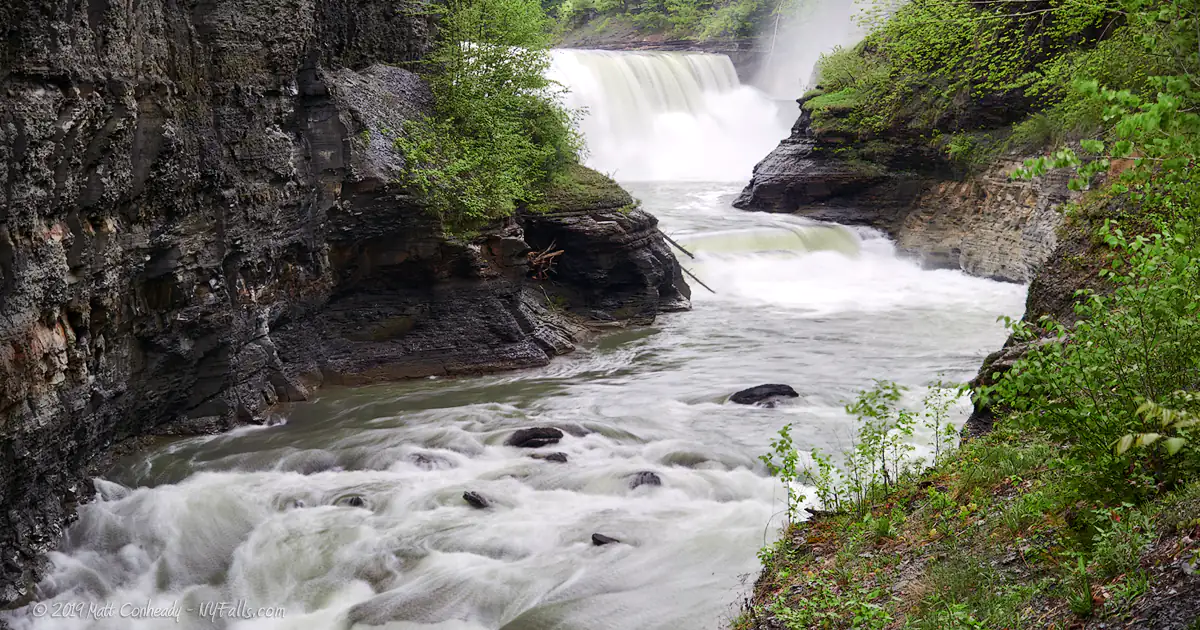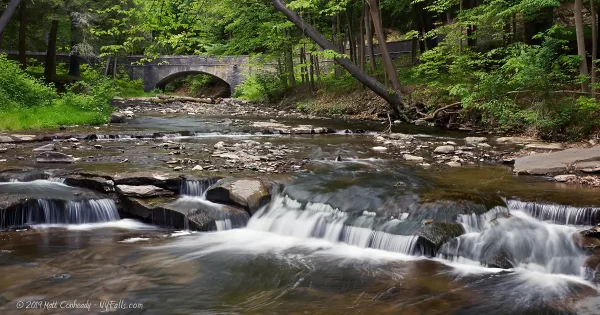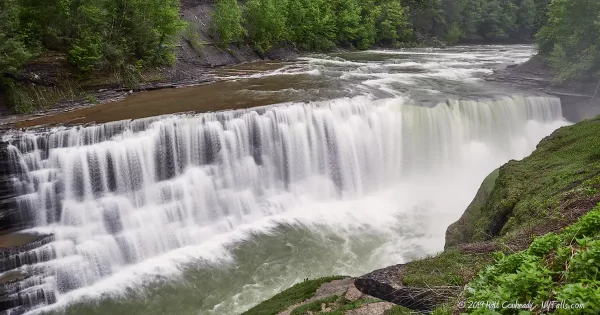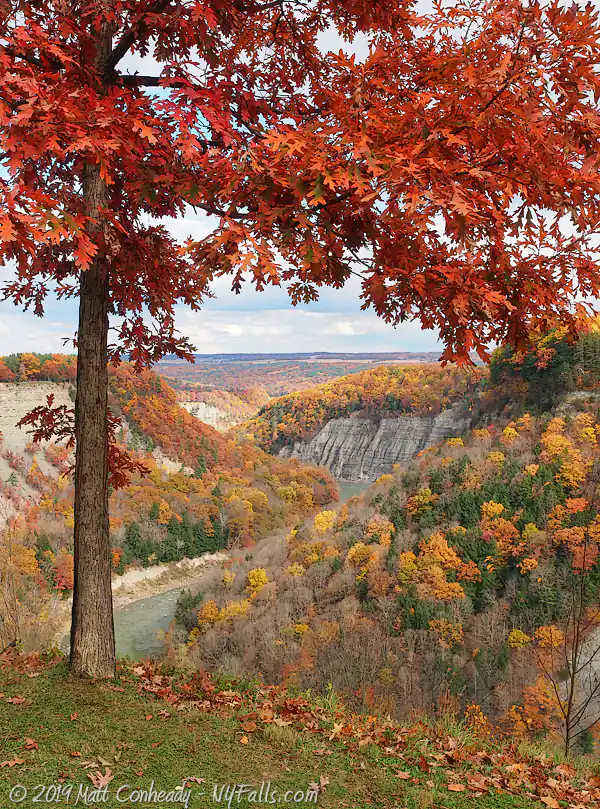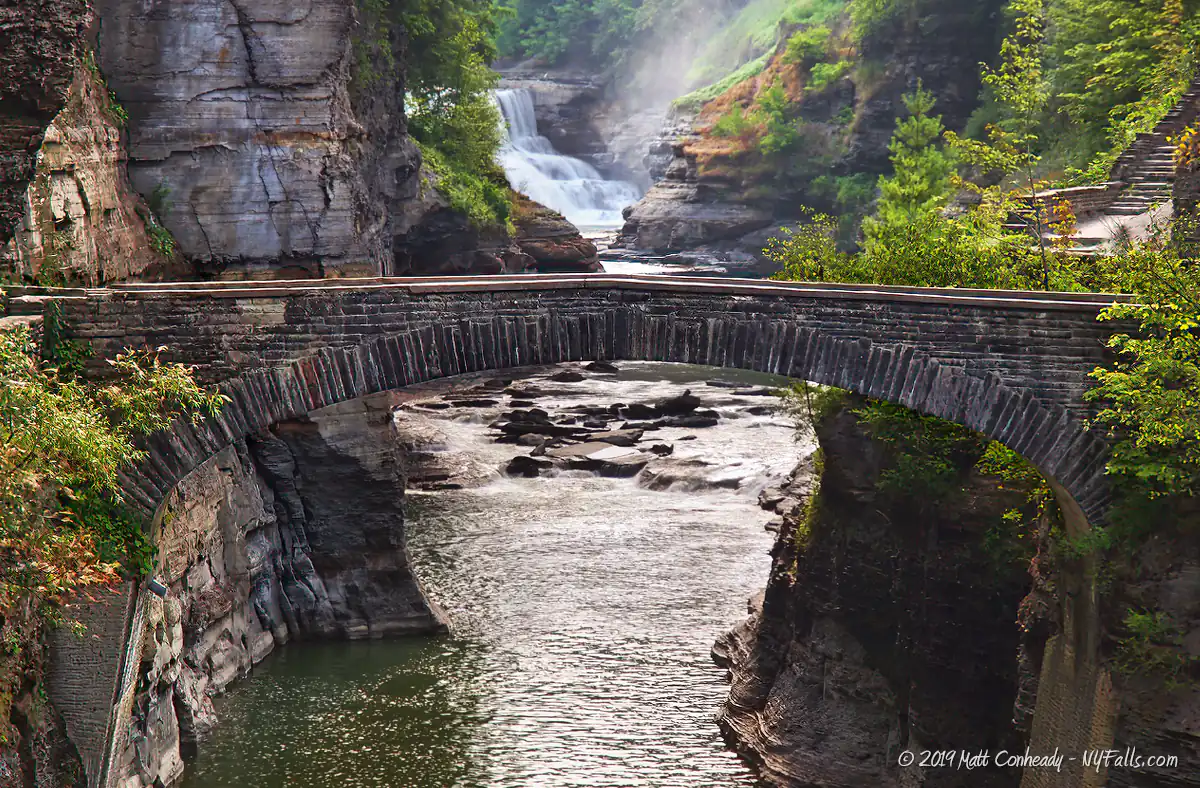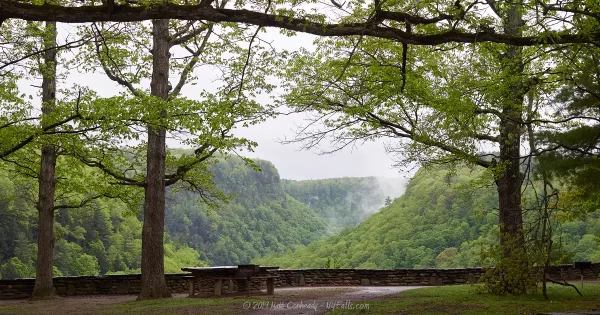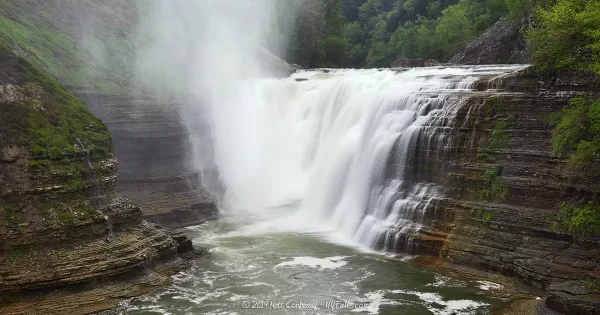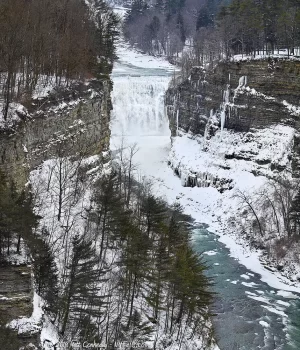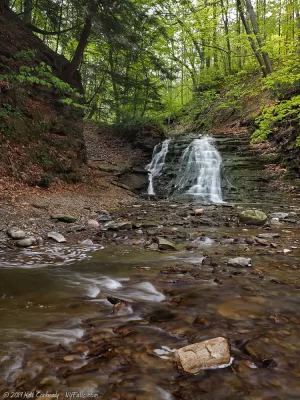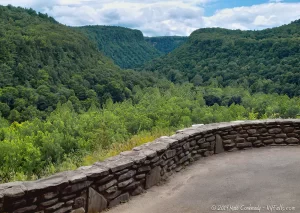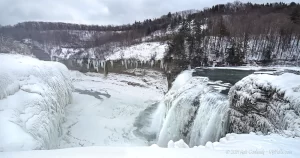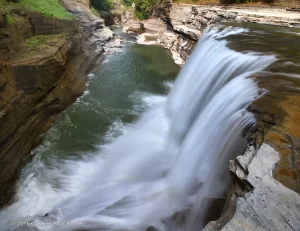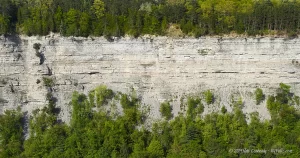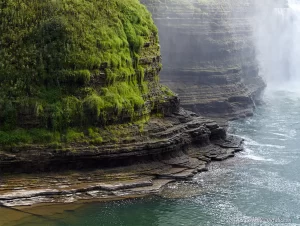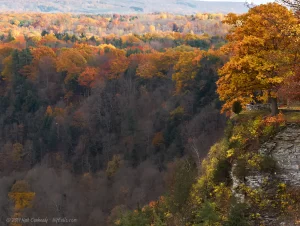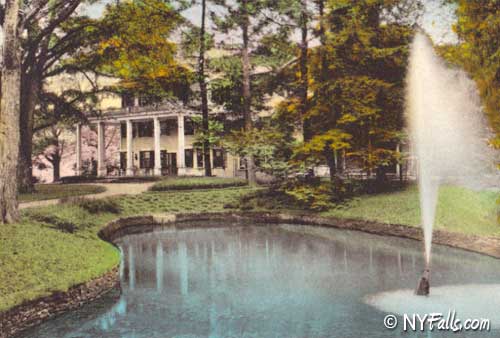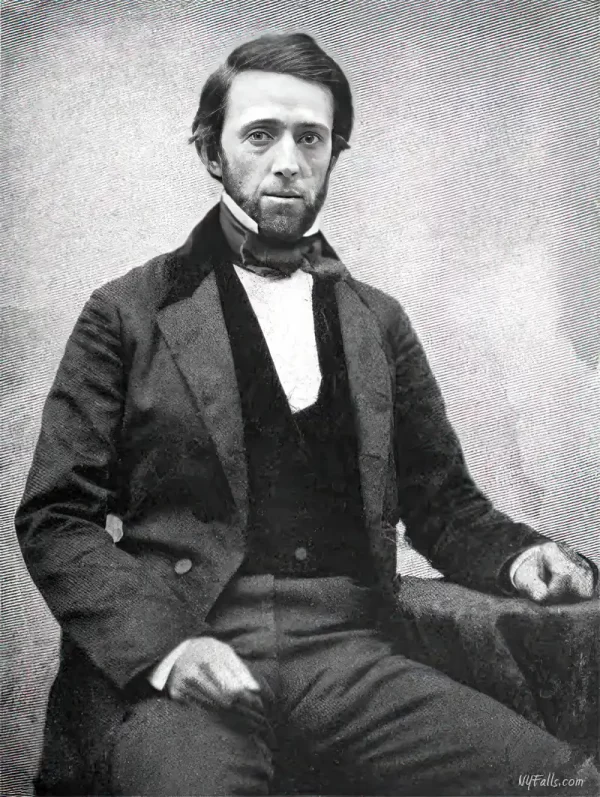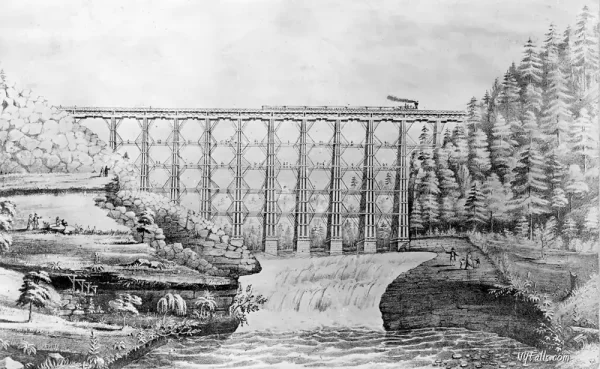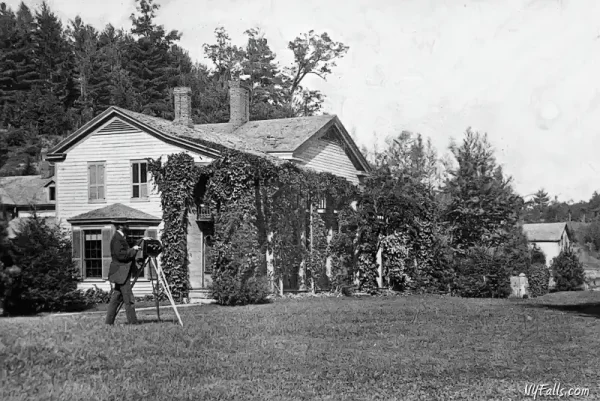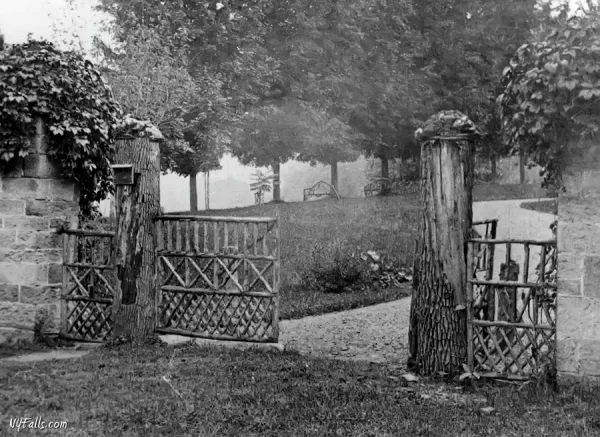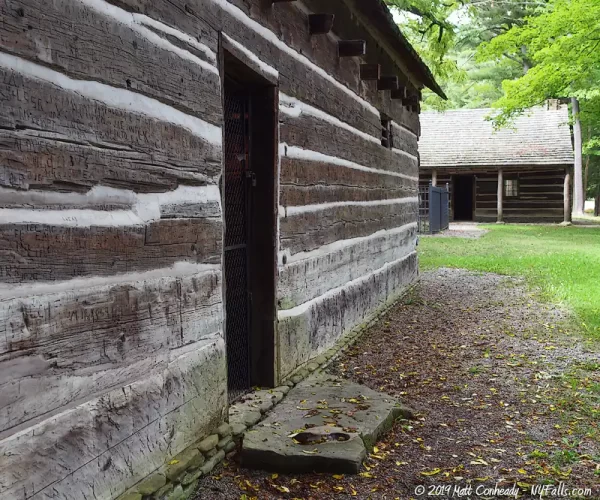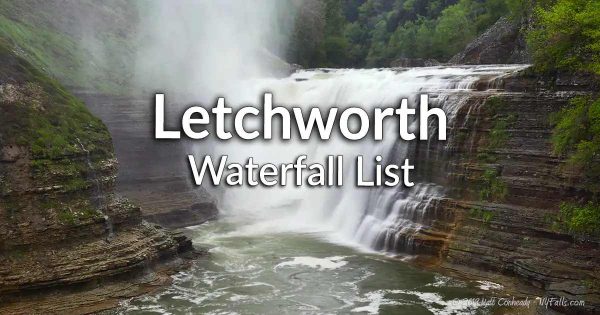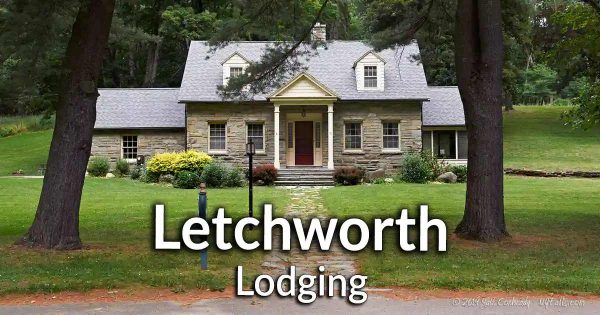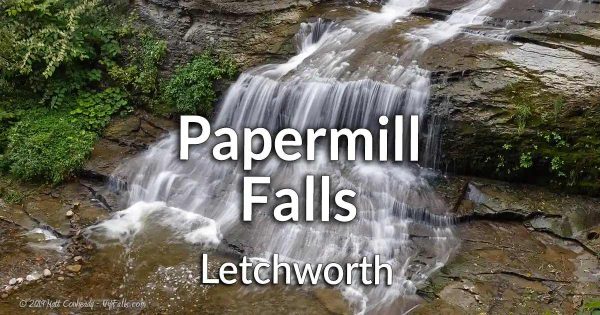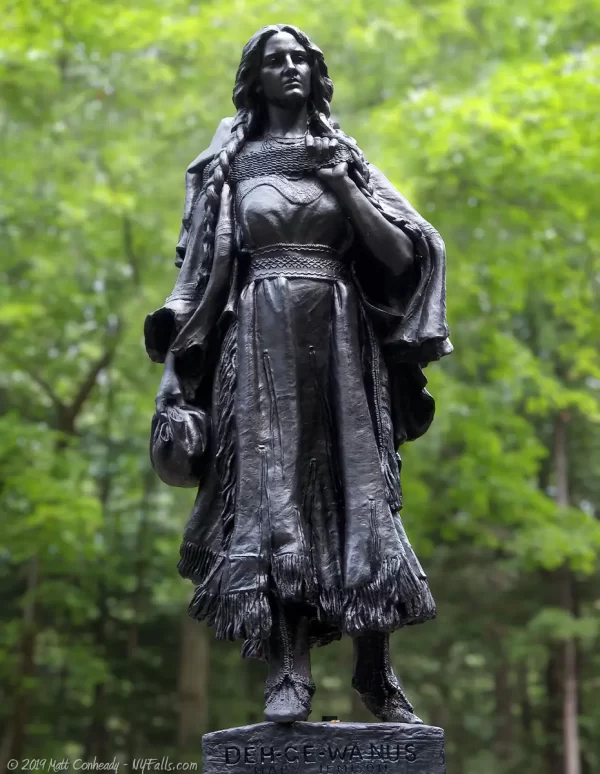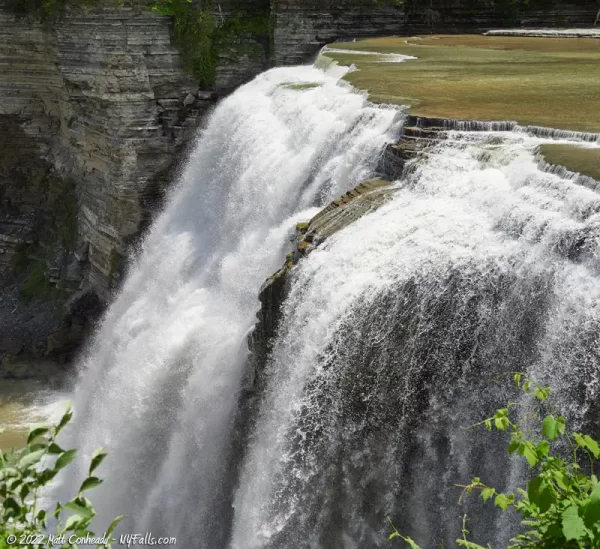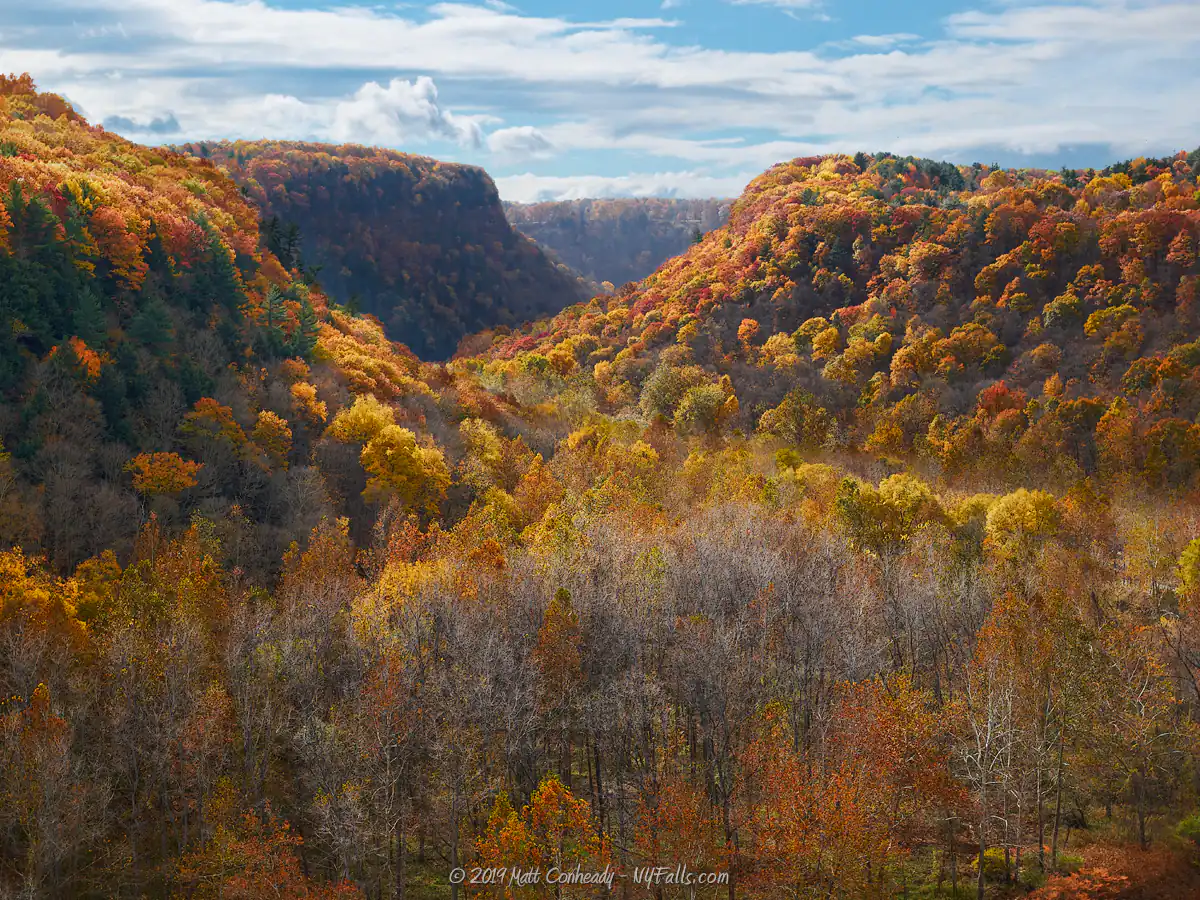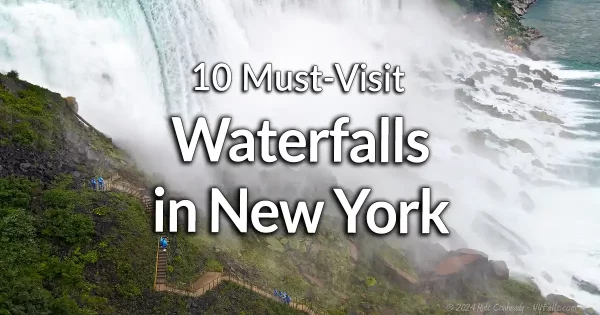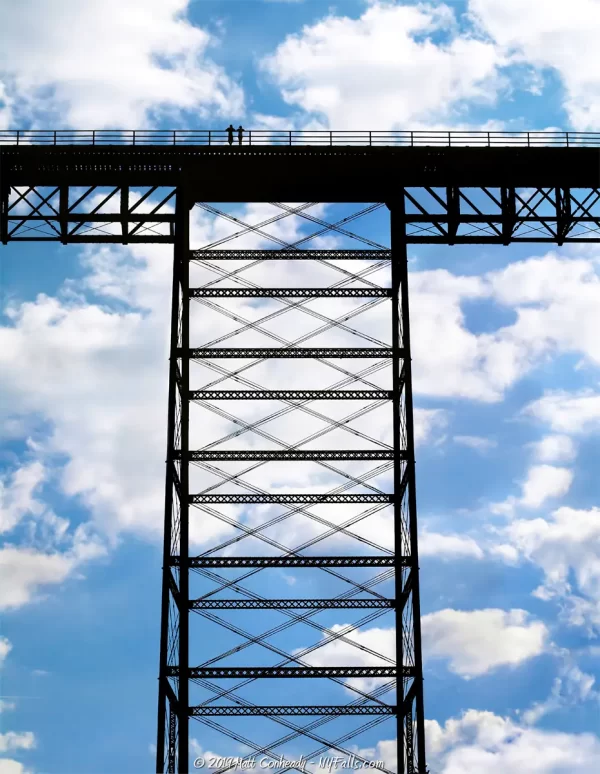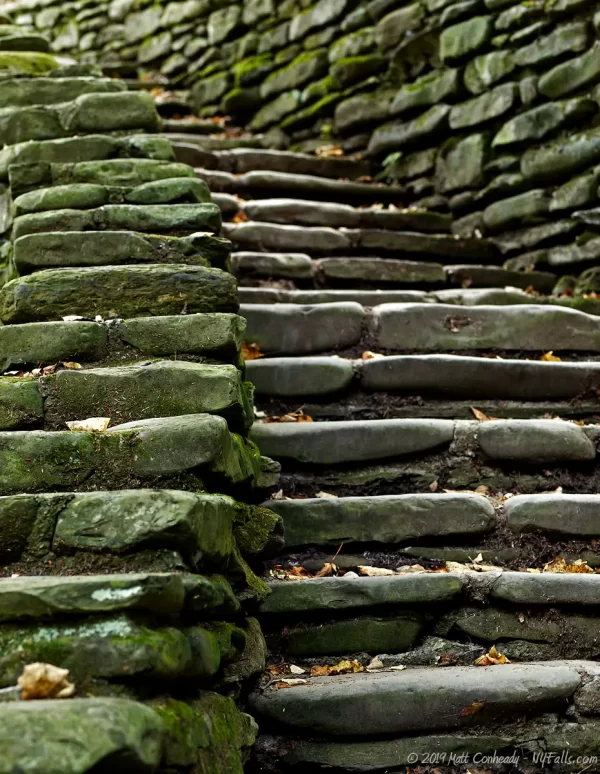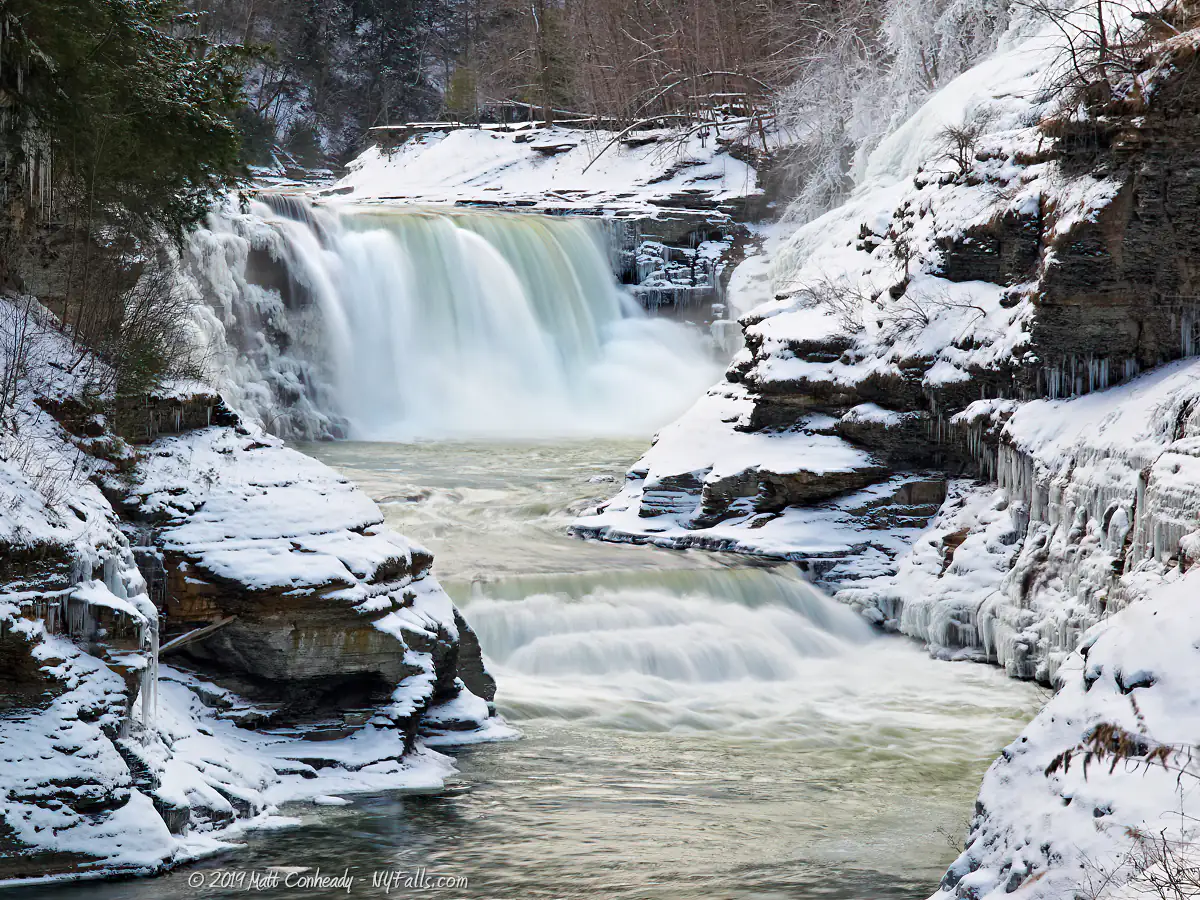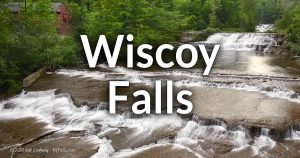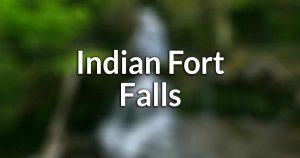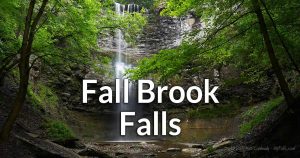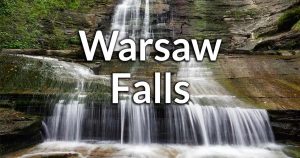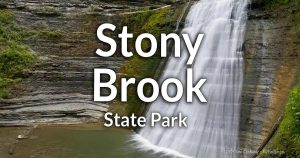Letchworth State Park
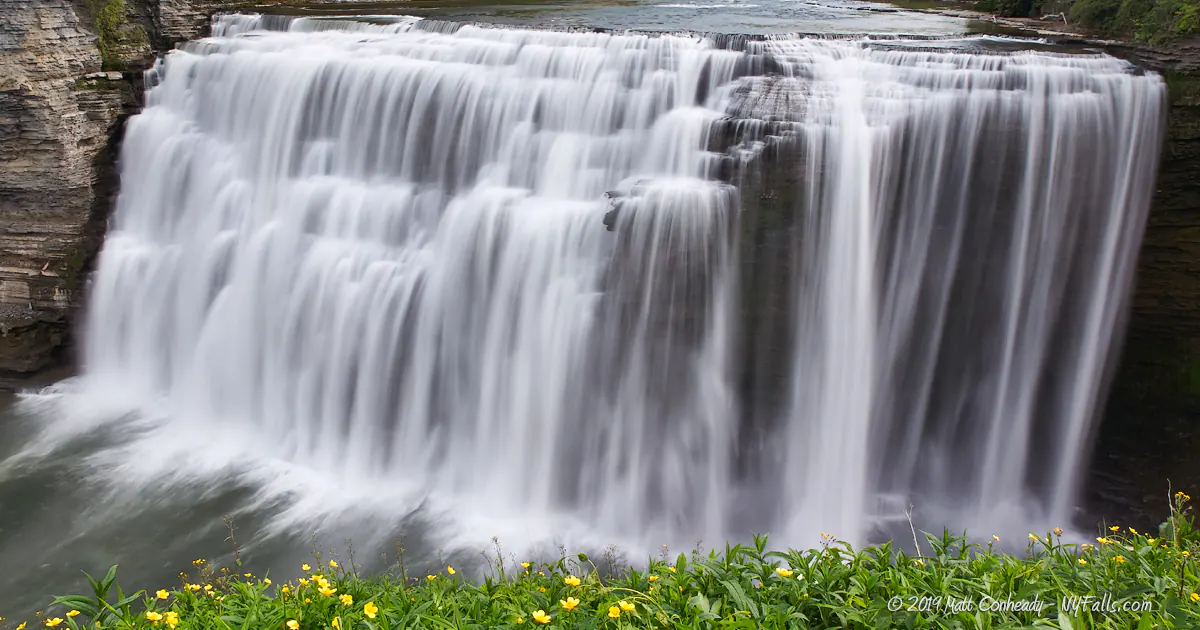
Location: 35 miles south/west of Rochester. Letchworth State Park spans multiple municipalities: Mt Morris, Perry, Castile and Nunda. Across Wyoming and Livingston counties, New York.
Maps: Google Map; Bing Map; Multi (topo); Park-Map (PDF); Trail Map North (PDF); Trail Map South (PDF); Interactive Map.
GPS/Locations: Click here for a complete list waterfall and viewing locations, including those off the beaten path.
Directions: There are numerous entrances into the park. Click the following links to obtain Google driving directions from your location to that particular entrance.
- Mt. Morris (north entrance, open all year, vehicle fee): Directions
- Perry (north-west entrance, open all year, vehicle fee): Directions
- Castile (south-west entrance, open all year, vehicle fee): Directions
- Portageville (south entrance, closed winters, vehicle fee): Directions
- Parade Grounds (south-east entrance, closed winters): Directions
Parking: There is no shortage of parking at Letchworth State Park. Most of the sections of the park have ample parking spaces, and in some areas, roadside parking is acceptable, just keep off the grass, especially when things are a bit muddy.
For the Upper and Middle Falls, including the Glen Iris Inn, 3 large parking lots at the south end of the park in Portageville cater to hundreds of cars and offer easy access to the waterfalls, gift shops, picnic facilities and restaurants. If it looks like the Glen Iris is prepping for a wedding, help out by parking in the lot further down the gorge.

Weather
Information / Accessibility / Accommodations
Number of falls: Most people come to Letchworth State Park to see the 3 popular waterfalls: Lower, Middle and Upper Genesee Falls, which can all be easily found by travelling up the main road.
There’s so much more for those willing to explore. There are several taller waterfalls that pour directly into the canyon as well as numerous smaller cascades throughout the park, accessible via the miles of trails.
Letchworth features one of the state’s highest seasonal waterfall: Inspiration Falls, which is seasonal, and only flows during heavy rain.
Size/Types: See our Letchworth waterfall location/information page for a full breakdown of all the waterfalls within the park. For folks visiting their first time, or those that just want to learn more about the park, stay on this page.
Best time to visit: All year. Letchworth gets crowded during summer and fall weekends. The gorge scenery is spectacular in fall, and can be wonderous in winter.
Flow: Fluctuates. Some tributaries dry up during summer months. Some waterfalls are only flowing during or shortly after high rainfall. The Genesee River may back up behind the dam and flood some falls. You can always count on the three main waterfalls to be flowing, and they are well worth the visit.
Waterway: The Genesee River (and tributaries). The Genesee originates in Ulysses, PA and empties into Lake Ontario to the north at Rochester.
Time: Letchworth can take from 4 hours (to drive through stopping at the major points) to multiple days to see everything.
Seasons/Hours: Park open all year. 6 am to 11 pm. Some entrances and trails will close for winter. Water levels in the early spring may flood some gorge trails.
Admission: $10 vehicle fee at Mt. Morris, Perry, Portageville and Castile entrances. Free at other entrances. In the winter and early spring, the collection stations may not be manned and entry is free. The vehicle entrance fee does not cover swimming. $2 suggested donation at the museum and also the nature center.
Handicap accessibility: Yes. Most trails are not, but viewing and picnic areas are. Restrooms seem to be mostly accessible.
Pets: Allowed on leash. Proof of inoculation required. Prohibited in park buildings, pools, and cabin areas. For the safety of your pet and other hikers, do not bring pets on the gorge trail. Use some common sense.
Camping: Letchworth is one of the best camping parks in the northeast. The park features 270 campsites and 82 cabins located in various communities in the park. Make a camping reservation here.
Swimming: Swimming is available in the Olympic pool at the Highbanks recreation area. There is a $2 fee for swimming. In recent years the Lower Falls area pool has been closed. Do not swim in the Genesee River. The currents are strong and you could die.
Accommodations: Restrooms; bed and breakfast at the historic Glen Iris Inn; 2 pools; benches; picnic facilities; trails; museum; nature center; conference center; snack bars; gift shops; playgrounds; nature and history tours; lectures; river rafting; hot air ballooning; horseback riding; fishing; hunting; x-country skiing; snowshoeing.
This park is a Carry-in Carry-out park; be sure to bring trash bags for your refuse.
Description
Often referred to as the “Grand Canyon of the East,” Letchworth State Park spans 14,427 acres, containing spectacular vistas across its 17 mile stretch along the Genesee River in Western New York. Over 66 miles of hiking trails spread throughout the park offer visitors a new experience every time they visit. One of these, the Gorge Trail, runs the rim of the gorge for most of its length, giving hikers spectacular views year-round. The park offers a wide range of facilities for visitors, including campgrounds, cabins, and a variety of recreational opportunities such as hiking, fishing, hunting, whitewater rafting, and cross-country skiing. There is also a visitor center, where visitors can learn about the history and natural features of the park. With so many activities it is easily the centerpiece of Western New York recreation and the stunning gorge and magical cascades create a visual treat for all.
Bisected by the Genesee River, the park offers both something for the leisurely visitor and the adventurous. The river gorge cuts through the valley yielding three major waterfalls along its path, while multiple cascades empty into the main gorge, making it a must-see destination for the waterfall lover. With sheer cliffs up to 550 feet high and a watershed miles across; there are plenty of opportunities to find a spectacular seasonal ribbon falls, such as Inspiration Falls, the highest in the state. The park is so large, and there’s so much to see and do, it’s fairly common for visitors to spend a whole day just driving down the main park road stopping at the various scenic overlooks and historic sites.
The State Parks department does an excellent job maintaining this park, providing well-groomed trails, first-class accommodations, exciting activities and interesting educational opportunities. There is always something going on at Letchworth, but at the same time, there are plenty of opportunities to be on your own and enjoy nature.
Hiking / Walking Trails
Difficulty: Variable. I depends on the trail you take. From the upper falls to the lower falls, the gorge trail, it’s a long moderate hike on a well-blazed trail with some inclines and exposed rocks/roots.
Markings: Park signs and colored blazes. Often overlaps with the park road, or parallels it on the grass.
Distance: The park has tens of miles of trails, more than can be hiked in a single day. To walk to the 3 main falls, you are looking at about a 1.8 mile trek from the Upper Falls to the Lower Falls.
Description: There are two types of trails in Letchworth State Park. The majority of the trails are wide, lined with stone or sufficiently cleared. Steps are generally stonework and well-kept. Some trails are even paved. The less beaten pathways are narrow, lined with dirt, rocks and branches. Many trails traverse down into the gorge and you must know the water levels and weather forecast (ask any park ranger or police, or in the visitor center) before hiking down into the gorge.
The trails in Letchworth State Park are so numerous, it is recommended that you invest in a detailed trail guide, which can be found at the visitor center. You may also obtain a Finger Lakes Trail map from the Finger Lakes Trail Conference. Trails range from a half-mile (the Portage Trail 6) to 24 miles in length (The Finger Lakes Trail -FLT).
Although one would expect the more mainstream trails to be safer than the lesser used ones, as a matter-of-fact even the most well-kept trails should be used with caution. In 2006, a portion of the gorge trail at the crest of Middle Falls fell over the edge due to erosion. This is a well-kept, paved area, often used as an overlook to the Middle Falls. Luckily no one was hurt. If bringing small children, keep in mind that a lot of these trails are strenuous, involving slippery surfaces, steep slopes, and many stone steps not ideal for children.
Map: Park-Map(PDF) ; Trail Map North (PDF); Trail Map South (PDF); Interactive Map.
Letchworth Park Interactive Map
Letchworth State Park Media
Letchworth State Park Videos


Letchworth State Park Audio
Lower Falls
Middle Falls Close Up (Hi-fi)
Middle Falls Side (Hi-fi)
Upper Falls Close Up (Hi-fi)
Letchworth State Park Photo Gallery
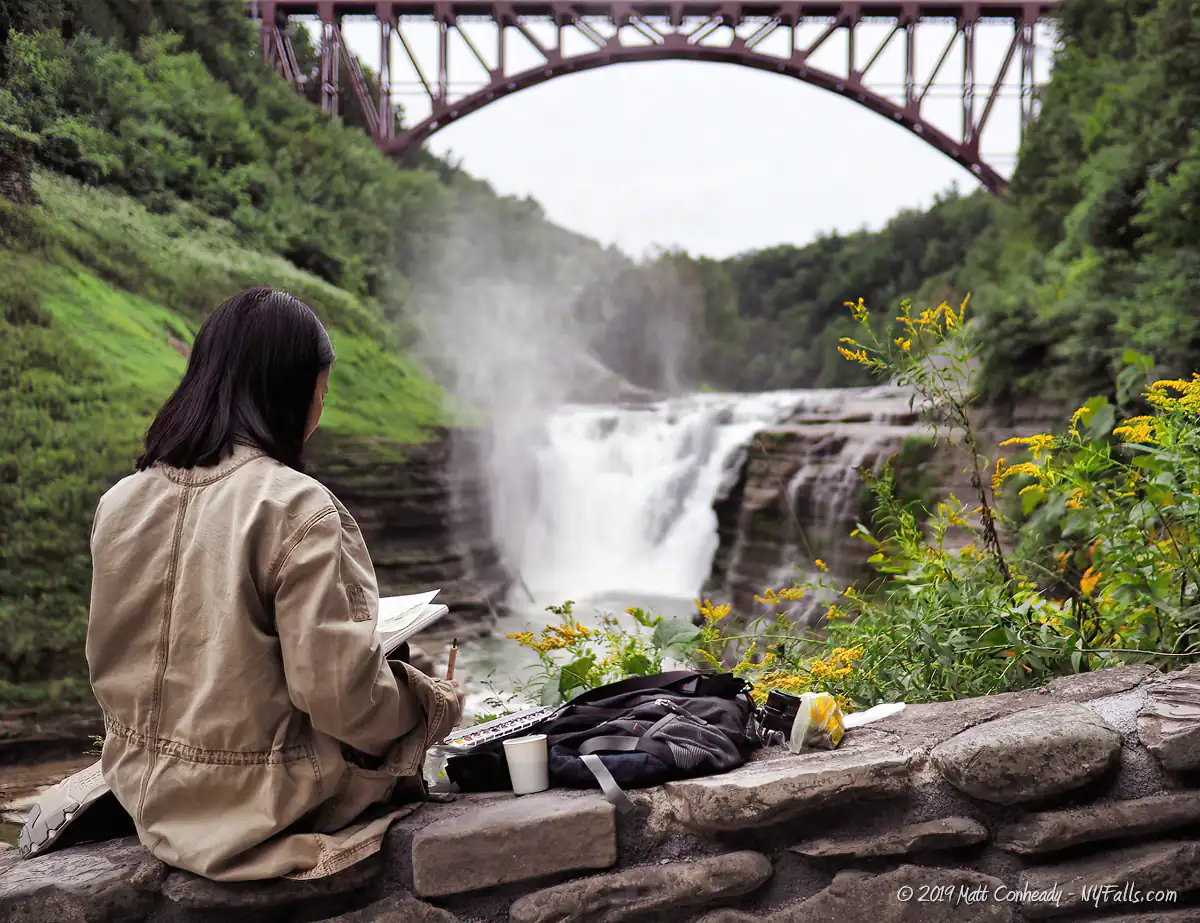
History
The Seneca Indians called the area Sehgahunda, meaning the “Vale of Three Falls,” forming several villages within what are now the park boundaries. Many of the trails in the park today are based on actual Seneca trails, which were used for river access.
During the French & Indian War in 1758 the teenage Mary Jemison of a Pennsylvania colony was taken captive by Shawnee Indians. She was accepted and raised in the Seneca ways and was called by her new family Dehgewanus, “Two Falling Voices.” Years later, she journeyed to Sehgahunda, losing her Delaware Indian husband to illness along the way. She took up residence with a related clan in the Gardeau Flats area. Over time the area shifted from Seneca Nation to frontier settlements. Mary Jemison, the “Old White Woman of the Genesee,” witnessed the sale and misuse of Sehgahunda land and the demise of the native inhabitants. She was eventually moved to a reservation in Buffalo where she passed. Now she is buried near the Glen Iris Inn and Middle Falls. A granite marker and statue mark the location.
Starting in the early 1800’s, the area was developing rapidly, gaining railroad access and canals. Tourism boomed as word spread of the grand vistas of the Portage Gorge. Along with progress came environmental destruction. The land was stripped of trees and industrialization lined the falls with mills and factories. The Portage Wooden High Bridge (the tallest and longest wooden railroad bridge of its kind when it opened on August 14, 1852) whisked tourists over the Upper Falls offering one of the few spectacular views of the gorge left.
One of those tourists was William Pryor Letchworth (May 26, 1823 – December 1, 1910), a successful iron tycoon from Buffalo, who was seeking an escape from the drudgery of business in the big city. Impressed by the remaining natural beauty of the Portage Gorge area and eager to preserve it as a paradise, he began purchasing land around the Middle Falls including a former farmhouse, which at the time was serving as a tourist inn and tavern. As it became available, he purchased adjacent land, began restoring the natural beauty and shared it with visitors. His efforts helped to transform the area into the tranquil, yet accessible natural area it is today.
Mr. Letchworth also concentrated on preserving the native heritage of his estate. He collected artifacts, documents and worked with surviving Native Americans to preserve and present the area’s history for visitors. To facilitate this he established the Council Grounds and Letchworth Museum. He also recognized Mary Jemison’s importance to the area and arranged to have her remains moved from her threatened reservation gravesite to rest in peace, close to home at the Glen Iris Estate.
Mr. Letchworth was more than a nature lover. He was a philanthropist at heart. He spent the latter portion of his life traveling across the county and into Europe establishing and supporting children’s charities. Although he wanted to donate the Glen Iris to an orphanage upon his death, industry was eyeing the Portage Gorge for hydroelectric power. The Genesee River Company had plans to dam the gorge just above the Upper Falls. Mr. Letchworth feared that what he dedicated his life to preserving would be in jeopardy. In a deal struck with the state of NY in 1906, the Glen Iris Estate would become a state park, and be afforded the protections against private development. It officially became Letchworth State Park in 1907. Mr. Letchworth died 3 years later.
While direct battles of the Civil war did not take place in this location, a Civil War encampment and battle reenactments are performed here yearly in mid-may. It’s worth checking out. Park events.
The Glen Iris Inn
The Glen Iris Inn is located within Letchworth State Park, adjacent to Middle Falls. The former summer home for William Pryor Letchworth and his family, the estate is easily the centerpiece of the upper gorge. The inn is a three-story, Victorian-style building made of brick and stone and is considered one of the best examples of 19th-century architecture in the area.
The Inn’s history starts well before Mr. Letchworth’s arrival.
In 1821, Alvah Palmer (of Shelburne, Vermont) built a small cabin, dam, and sawmill on this site at the Middle Falls, and farmed the land to the south with his family. A few years later, they updated the cabin, expanding it and adding a second story.
Michael Smith, a French immigrant, and his business partner Theodore Olcott, of Albany, purchased the home and land from Palmer around 1832. While the mill business was booming, they intended on using the land for tourism. Smith made drastic modifications to the house, and for a time, a tavern, the Cataract House, operated on the property. His daughter, Miss Melinda Smith responded to an inquiry William Letchworth had about the history of the property with the following:
My father, in partnership with Mr. Theodore Olcott of Albany, bought the Glen Iris property sometime in the 30’s, though the place where the house stands was bought a little later. The southern part of the house stood on the place where it was bought, but father had the kitchen and pantry moved off, and the rest of the house moved back, and built the upright, finishing it in 1850. Mr. Smith leased the house for four years to two different tenants, two years to each.
In summary, the old Palmer place was modified and moved. He also constructed what is now the main, taller portion of the house (that faces the falls).
Miss Smith also noted that in the fall of 1854, the house was moved back yet again.
Smith and Olcott’s business didn’t pan out so well and they both went into considerable debt, with Smith unable to pay off his mortgage to his partner. Olcott’s stake in the property passed on to his brother Thomas. William Letchworth purchased the property in 1859 for $7,001, with $7,000 going to Thomas Olcott and $1 to Smith, who had been living in the house at the time. Accounting for inflation the price paid by Letchworth, was roughly $250,000.
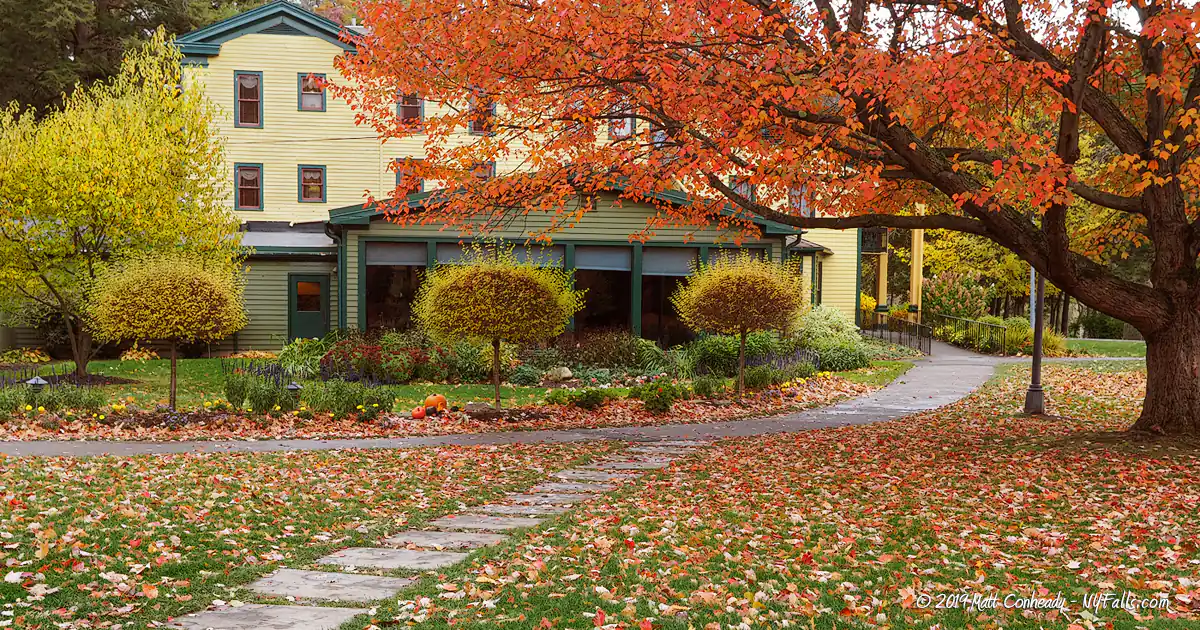
Letchworth’s goals for the estate were clear: preserve what can be preserved, and beautify what needs to be beautified. The Seneca called this place “An-de-ka-ga-kwa”, which means “the place where the sun lingers”, referring to the natural phenomenon where the sun seems to shine a bit longer in this section of the gorge, through the falls. Letchworth took some inspiration from this, but also from what he could see with his plain eyes, and chose to name his estate Glen Iris. In this case, “Iris” is the synonym for rainbow. He decided to preserve much of the house, although he did renovate the interior away from being an Inn and Tavern and towards a more intimate home and study. Much of the major work performed to the property was to the grounds, as Letchworth commissioned Rochester landscape architect William M. Webster (1817-1911), a student of Frederick Law Olmsted and James Vick. Webster also laid out the grounds for the University of Rochester, Alfred College, Keuka College, Cornell University’s entrance, Kodak Park in Rochester, and many other public and private properties around the US. A part of Webster’s plan for the property was to tear down the old home and replace it with with a larger, modern home to the south between Upper and Middle Falls. Letchworth refused.
Under Letchworth’s ownership, dozens of gardens and thousands of trees were planted to restore the Portage Gorge from the scars of the milling industry. Barns and other existing buildings were renovated, and new structures were built. Having traveled to Europe and taking a liking to Swiss architecture, he constructed two Swiss-style cottages on the grounds in the 1870s. One for the caretaker, and the other, Lauterbrunnen Farm to host family and guests. The caretakers’ cottage has since been demolished, but the Lauterbrunnen now serves guests as the The Chalet House.
Letchworth spent much of his free time at the Glen Iris, directing improvements to the grounds and hosting family and friends. Not married and having no kids, but one of 8 children himself, he took it upon himself to host his family and share his love for the Glen Iris. The “Portage Rangers” was the name given to his young nieces and nephews who would go off and play in the forests and glens nearby. He also regularly hosted a group of friends from Buffalo, known as the “Nameless Club,” who shared his love for art and literature. Guests of the Glen Iris often wrote poems about the place, leaving them with Mr. Letchworth. He published a compilation of that poetry in a 1876 book, “Voices of the Glen.”
The public was not barred from enjoying his land, as he regularly let them come and enjoy the falls and forests on the estate. The front gate, unlocked, simply had a sign asking visitors to close the gate behind them. He encouraged visitors to not only take in the natural beauty, but to learn from it as well. By the 1870s, the place was a well known tourist destination, and railroads began running trains to the glen on Sundays and holidays. Once they were coming by the train-load, and the wear and tear on the Glen Iris became evident, he began to protest, but people still came, and he accommodated them.
In 1880, retired and looking to live at the summer cottage for the remainder of his time, Letchworth added a 3rd story to the main structure of the house. Buffalo architect, Alexander F. Oakley, did this work while preserving the original Greek Revival look of the glen-facing facade. On that newly added floor was his bedroom, and office, from which he worked as a member of the New York State Board of Charities. Oakley also added a grand stairway and entrance hall, as well as the library, which now serves as the gift shop.
In 1907, Letchworth gifted his property and all structures to the State of New York, to turn it into a public park, to properly host and educate tourists. The deed allowed him to live out his life in the house and on the grounds, and he did, until Dec. 1, 1910 in his bedroom on the 3rd floor.
After his passing, the house was used as the newly developing park’s headquarters for a few years, but shortly after was used informally as an inn, managed by a single housekeeper. The going rate for a room at the time was $.75 per night. Meals were an additional $.75. That’s about $25 in 2023 dollars. The inn utilized Mr. Letchworth’s original furniture, including his own bed.
As demand grew, the need to renovate the house to create a more accommodating inn grew with it. Extensive renovations were completed in 1913, creating 12 proper guest rooms, including the installation of proper baths and toilets (although some shared by rooms), as well as electrifying the house. The dining room was enlarged to accommodate more traffic, and public restrooms were added. It opened to guests as the Glen Iris Inn on May 11, 1914, under the management of Innkeepers Mr. and Mrs. Charles Baeder. Original furniture, and decor, now augmented by new items were still in the house and enjoyed by guests. Rooms were $2/$3 (Single/Double) per night ($60/$90 adjusted for inflation), and meals were $1 (about $30 in 2023). It continued to operate with ongoing restorations to accommodate more park guests, including a dining room expansion in 1973, and then an expansion of the main floor of the back in 1978. Additional bathrooms were added and a modern service kitchen was added by 1982.
Today, the inn features period furnishings and decor, including the 1880 grand staircase, fireplaces, bookcases, and beautiful stained glass windows of Letchworth’s era. The rooms are decorated in Victorian style, and some of them offer views of the park and the falls. The restaurant, Caroline’s, serves locally-sourced and seasonal cuisine in a fine-dining atmosphere that is also very welcoming to park visitors who may be a little underdressed and have a touch of mud on them from the trails. For park guests, they also offer bag lunches for picnicking. Weddings can also be hosted here, and it’s not uncommon for a park guest to stumble unknowingly into a wedding photo.
The Glen Iris Inn is a National Historic Landmark and is listed on the National Register of Historic Places. It continues to be a popular destination for visitors to Letchworth State Park, offering a unique and authentic experience of the park’s history and natural beauty.
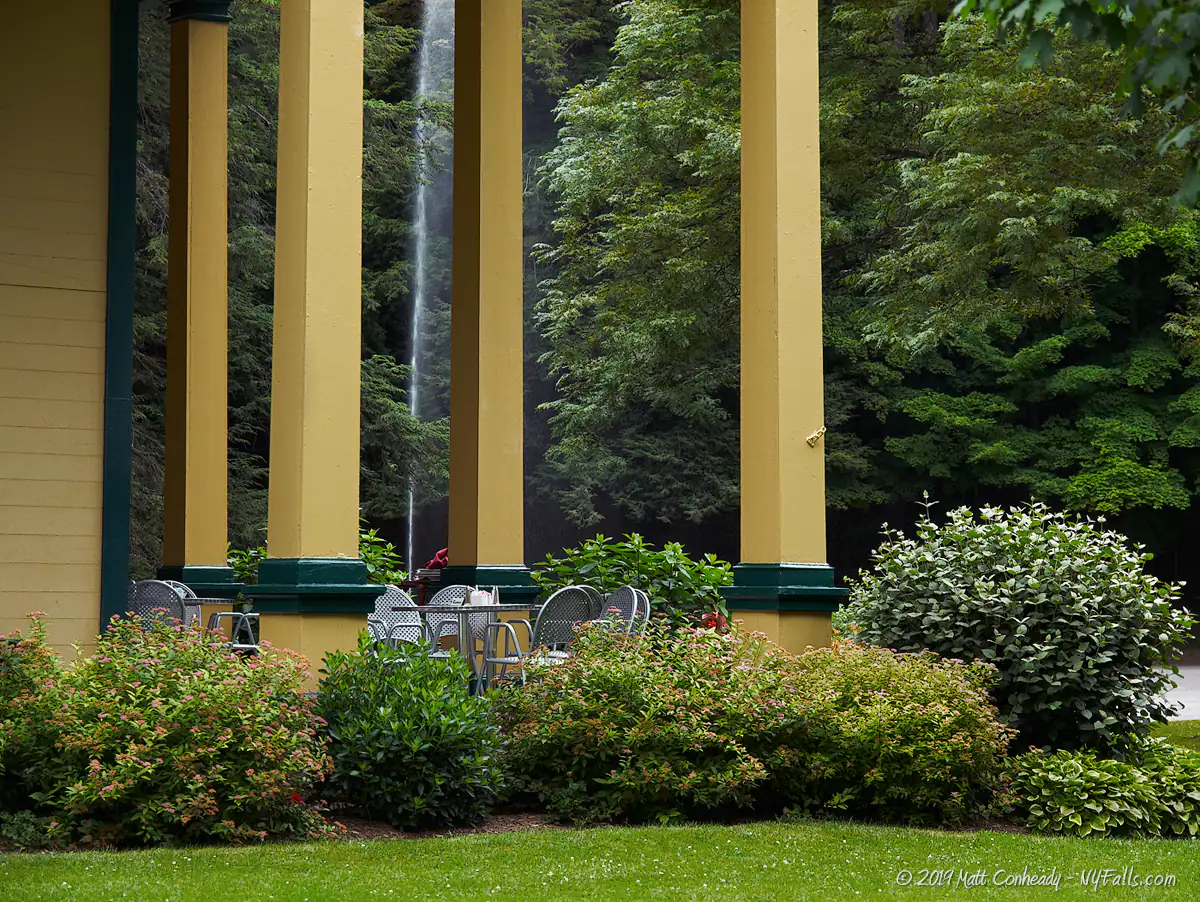
Other Letchworth Pages
All the Waterfalls in the park and where to find them
Letchworth State park has dozens of waterfalls along its many tributaries. Some can only be seen after heavy rain. Others just require you to cross to the other side of the gorge.
Where to Stay
Descriptions of the camping and lodging options available in the park. From the luxurious and historic Glen Iris Inn to the forested campsites around the park.
Gibsonville and Historic Papermill Falls
Gallery and information on this historic section of the park. An abandoned milling community eventually became a Civilian Conservation Corp camp, and now one of the most interesting sections of the park.
Interesting Stuff
Council Grounds
On the hill behind the museum, near the Glen Iris are the Council Grounds, where William Letchworth has historic Seneca buildings moved and restored.
Mary Jemison
Born in 1743 in Pennsylvania, Mary was just 12 years old when her family was killed during a raid by a group of Shawnee Indians. She was captured and eventually sold to the Seneca tribe, who adopted her as one of their own. Mary quickly adapted to her new way of life and eventually came to identify as Seneca, even after her eventual release and return to white society. She settled in the Genesee Valley, within the boundaries of the present-day park and became a legendary figure in the pioneer history of the region and known to all as the “White Woman of the Genesee.” A statue of her can be found at the Council Grounds.
Middle Falls – Illuminated
Stick around after dark to see the Middle Falls lit up. Sure, it’s not as big or colorful as Niagara Falls’ Illumination, but it’s well worth the wait and makes for excellent photo opportunities.
Genesee Greenway View
Trail 7 from the Parade Grounds entrance towards High Falls offers spectacular views of the falls and a peaceful, less crowded environment than the other side of the gorge.
Weddings
A popular place for weddings, the Glen Iris caters to the formal affair, but it is not uncommon to see couples in less formal, but highly romantic ceremonies in other locations in the park, such as the Tea-Table overlook and Inspiration Point.
Lower Falls Erosion
Although Lower Falls seems as though it has not changed in a long time, pioneer sketches show it breaking right at Cathedral Rock. That means it has eroded over 1,000 feet upstream in about 150 years.
The Face in the Falls
When flow is slow, such as during a slight drought, or sometimes in the middle of summer, the silhouette of a face can be seen in a rock outcropping in the top center face of Middle Falls, below the Glen Iris. It’s best seen from the walkway along the falls.
10 Must-Visit Waterfalls In New York State
A selection of the most popular and accessible waterfalls around the State of New York. From Niagara Falls in Western NY to Kaaterskill Falls in the Hudson Valley Region.
Photography Tips
Who to Contact
Letchworth State Park
1 Letchworth State Park
Castile, NY 14427
Visitor Center: (585) 493-3600
NYS Park Police: (585) 658-4692
The Glen Iris Inn: (585) 493-2622
Campground: (585) 237-3303
Special activities
Adventure Calls Outfitters River Rafting
Phone: (585) 343-4700
adventure-calls.com
Balloons Over Letchworth
Phone: (585) 493-3340
balloonsoverletchworth.com
Wolcott Farms Horseback Riding Phone: (585) 493-3340
wolcottfarms.com




